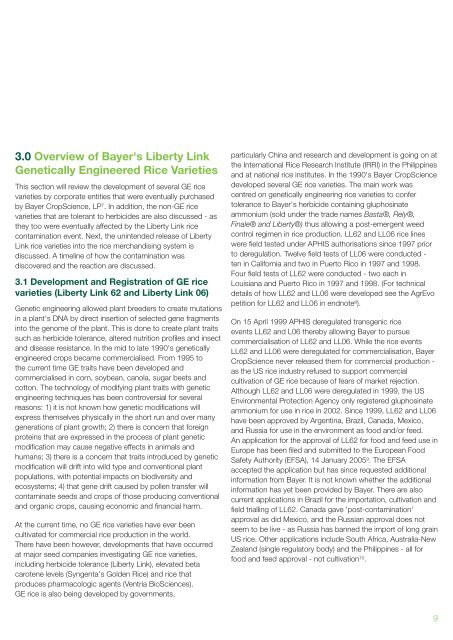Risky Business - Greenpeace
Risky Business - Greenpeace
Risky Business - Greenpeace
Create successful ePaper yourself
Turn your PDF publications into a flip-book with our unique Google optimized e-Paper software.
3.0 Overview of Bayer's Liberty Link<br />
Genetically Engineered Rice Varieties<br />
This section will review the development of several GE rice<br />
varieties by corporate entities that were eventually purchased<br />
by Bayer CropScience, LP 7 . In addition, the non-GE rice<br />
varieties that are tolerant to herbicides are also discussed - as<br />
they too were eventually affected by the Liberty Link rice<br />
contamination event. Next, the unintended release of Liberty<br />
Link rice varieties into the rice merchandising system is<br />
discussed. A timeline of how the contamination was<br />
discovered and the reaction are discussed.<br />
3.1 Development and Registration of GE rice<br />
varieties (Liberty Link 62 and Liberty Link 06)<br />
Genetic engineering allowed plant breeders to create mutations<br />
in a plant's DNA by direct insertion of selected gene fragments<br />
into the genome of the plant. This is done to create plant traits<br />
such as herbicide tolerance, altered nutrition profiles and insect<br />
and disease resistance. In the mid to late 1990's genetically<br />
engineered crops became commercialised. From 1995 to<br />
the current time GE traits have been developed and<br />
commercialised in corn, soybean, canola, sugar beets and<br />
cotton. The technology of modifying plant traits with genetic<br />
engineering techniques has been controversial for several<br />
reasons: 1) it is not known how genetic modifications will<br />
express themselves physically in the short run and over many<br />
generations of plant growth; 2) there is concern that foreign<br />
proteins that are expressed in the process of plant genetic<br />
modification may cause negative effects in animals and<br />
humans; 3) there is a concern that traits introduced by genetic<br />
modification will drift into wild type and conventional plant<br />
populations, with potential impacts on biodiversity and<br />
ecosystems; 4) that gene drift caused by pollen transfer will<br />
contaminate seeds and crops of those producing conventional<br />
and organic crops, causing economic and financial harm.<br />
At the current time, no GE rice varieties have ever been<br />
cultivated for commercial rice production in the world.<br />
There have been however, developments that have occurred<br />
at major seed companies investigating GE rice varieties,<br />
including herbicide tolerance (Liberty Link), elevated beta<br />
carotene levels (Syngenta's Golden Rice) and rice that<br />
produces pharmacologic agents (Ventria BioSciences).<br />
GE rice is also being developed by governments,<br />
particularly China and research and development is going on at<br />
the International Rice Research Institute (IRRI) in the Philippines<br />
and at national rice institutes. In the 1990's Bayer CropScience<br />
developed several GE rice varieties. The main work was<br />
centred on genetically engineering rice varieties to confer<br />
tolerance to Bayer's herbicide containing gluphosinate<br />
ammonium (sold under the trade names Basta®, Rely®,<br />
Finale® and Liberty®) thus allowing a post-emergent weed<br />
control regimen in rice production. LL62 and LL06 rice lines<br />
were field tested under APHIS authorisations since 1997 prior<br />
to deregulation. Twelve field tests of LL06 were conducted -<br />
ten in California and two in Puerto Rico in 1997 and 1998.<br />
Four field tests of LL62 were conducted - two each in<br />
Louisiana and Puerto Rico in 1997 and 1998. (For technical<br />
details of how LL62 and LL06 were developed see the AgrEvo<br />
petition for LL62 and LL06 in endnote 8 ).<br />
On 15 April 1999 APHIS deregulated transgenic rice<br />
events LL62 and L06 thereby allowing Bayer to pursue<br />
commercialisation of LL62 and LL06. While the rice events<br />
LL62 and LL06 were deregulated for commercialisation, Bayer<br />
CropScience never released them for commercial production -<br />
as the US rice industry refused to support commercial<br />
cultivation of GE rice because of fears of market rejection.<br />
Although LL62 and LL06 were deregulated in 1999, the US<br />
Environmental Protection Agency only registered gluphosinate<br />
ammonium for use in rice in 2002. Since 1999, LL62 and LL06<br />
have been approved by Argentina, Brazil, Canada, Mexico,<br />
and Russia for use in the environment as food and/or feed.<br />
An application for the approval of LL62 for food and feed use in<br />
Europe has been filed and submitted to the European Food<br />
Safety Authority (EFSA), 14 January 2005 9 . The EFSA<br />
accepted the application but has since requested additional<br />
information from Bayer. It is not known whether the additional<br />
information has yet been provided by Bayer. There are also<br />
current applications in Brazil for the importation, cultivation and<br />
field trialling of LL62. Canada gave 'post-contamination'<br />
approval as did Mexico, and the Russian approval does not<br />
seem to be live - as Russia has banned the import of long grain<br />
US rice. Other applications include South Africa, Australia-New<br />
Zealand (single regulatory body) and the Philippines - all for<br />
food and feed approval - not cultivation 10 .<br />
9

















